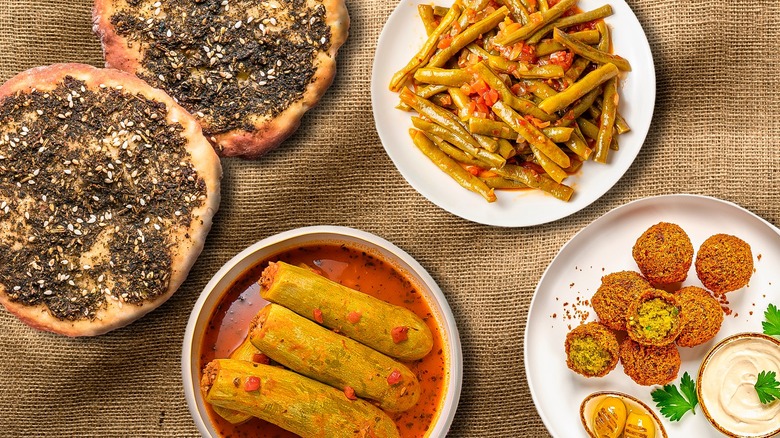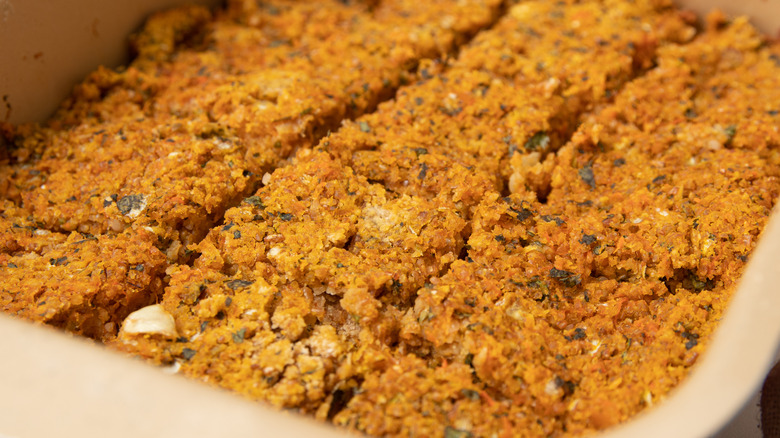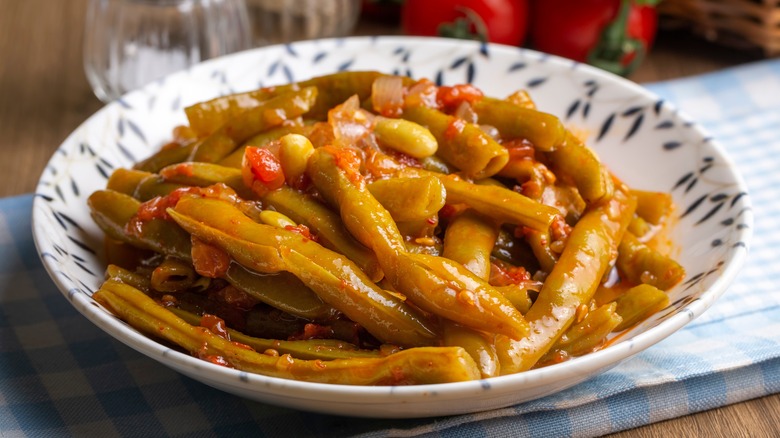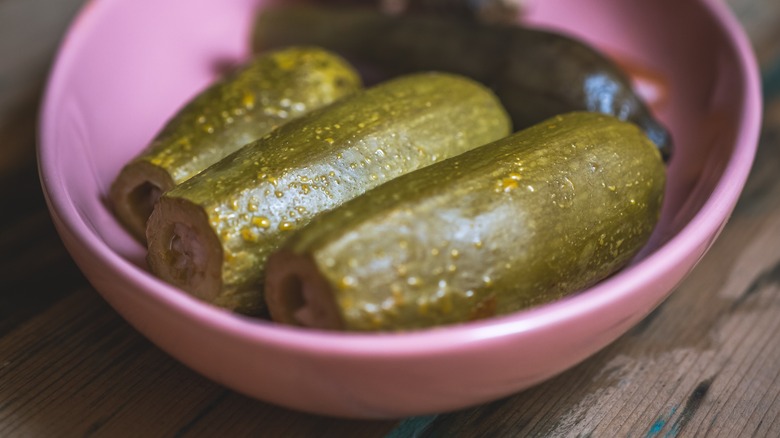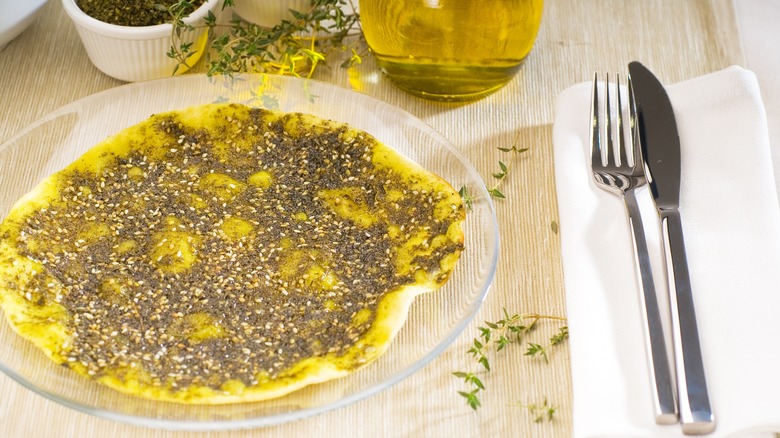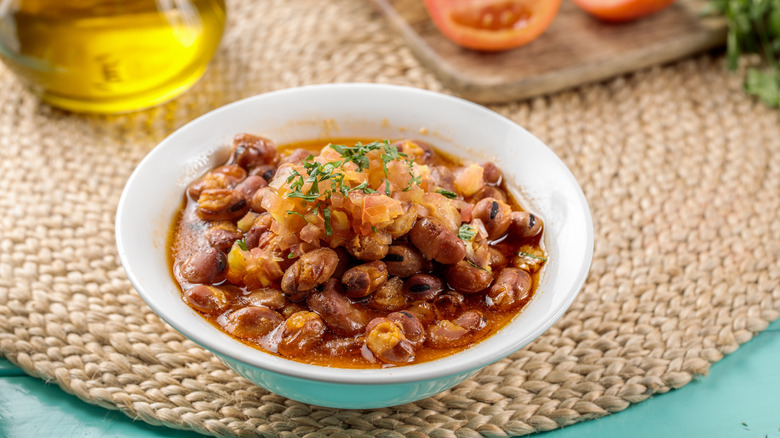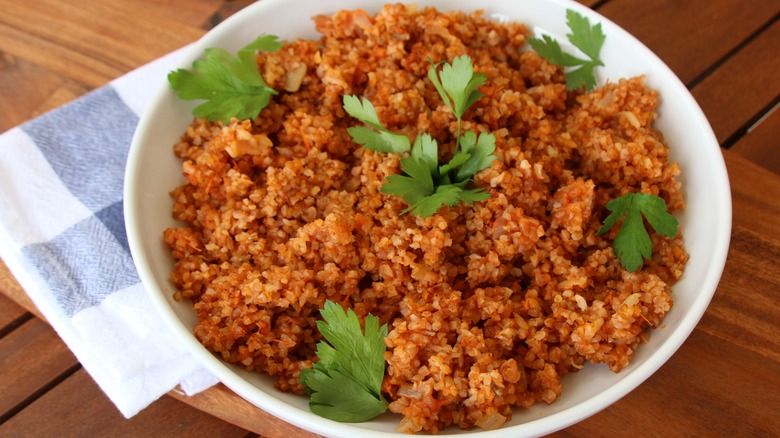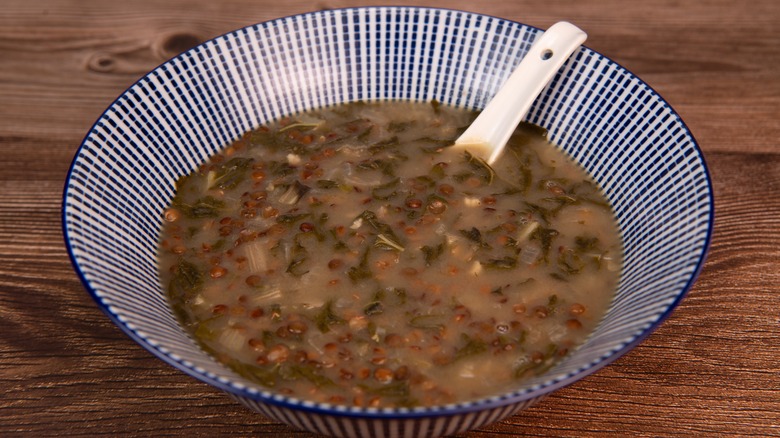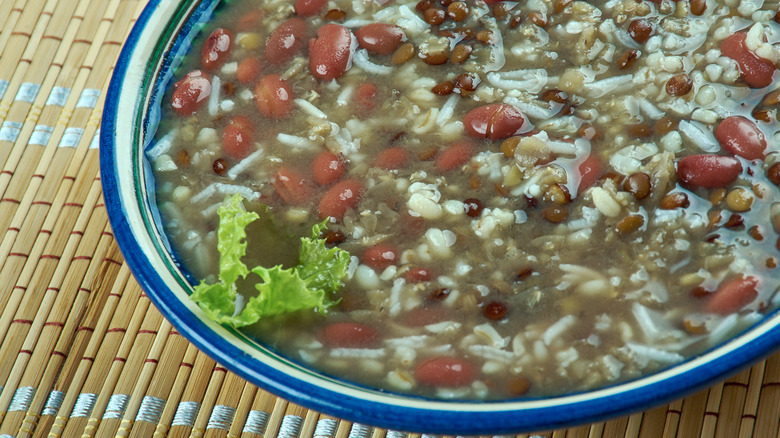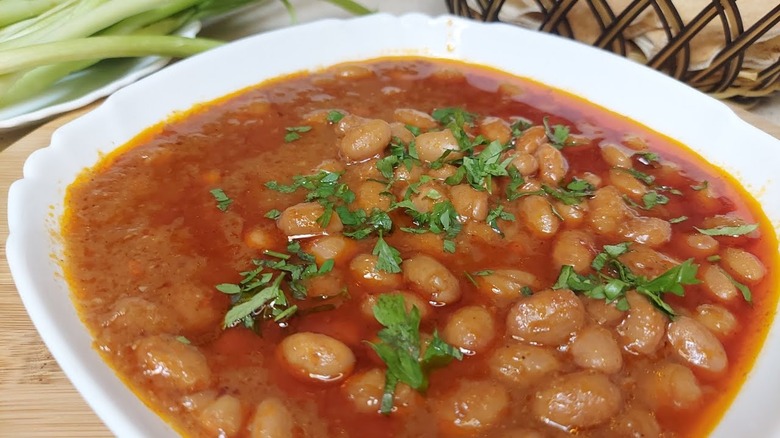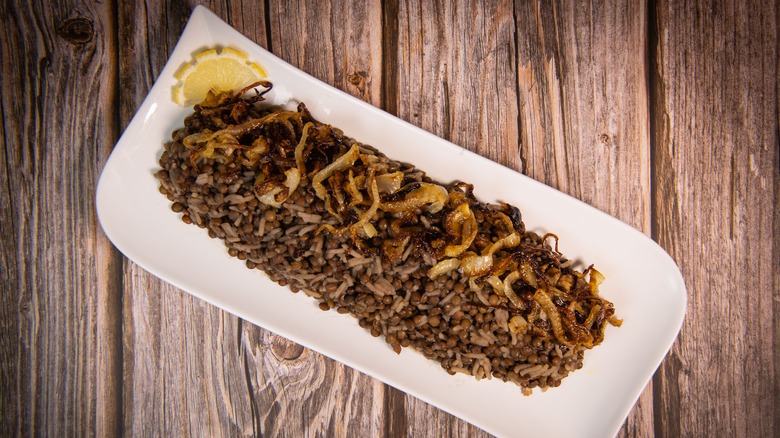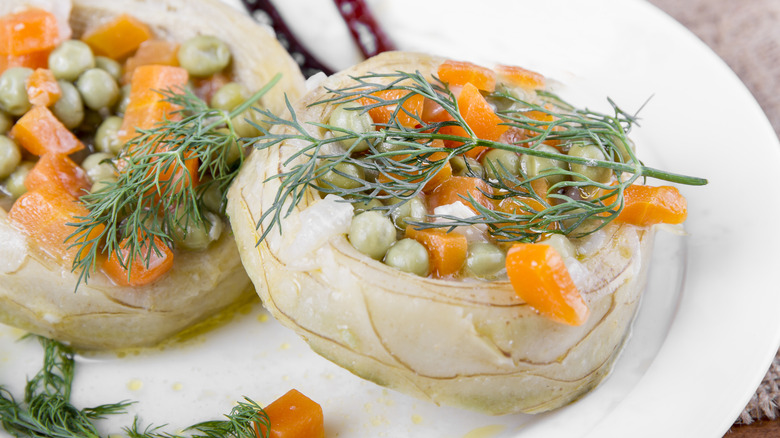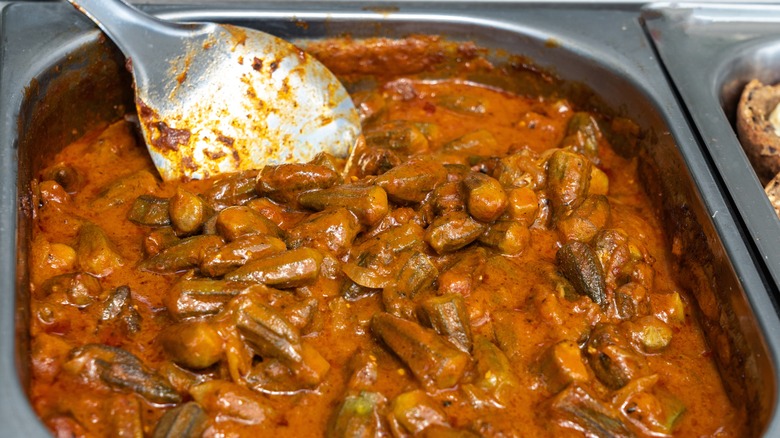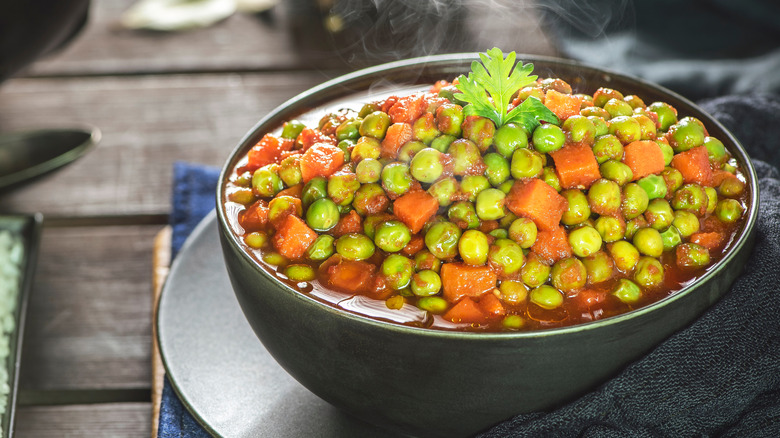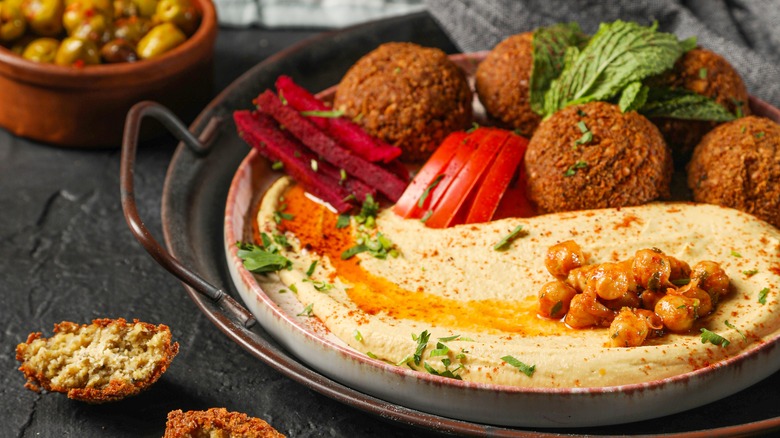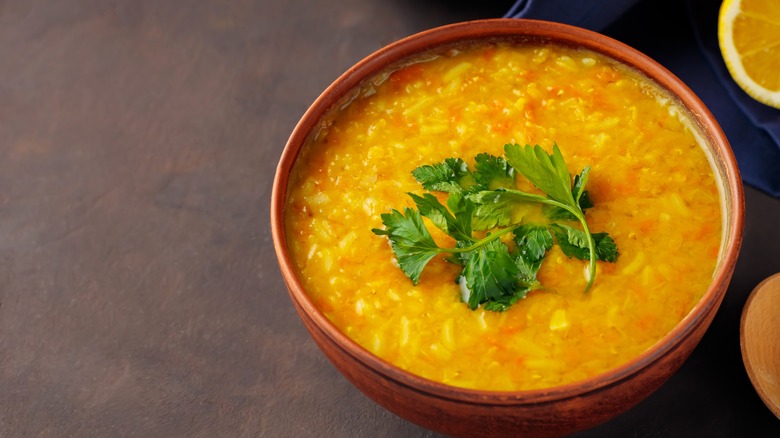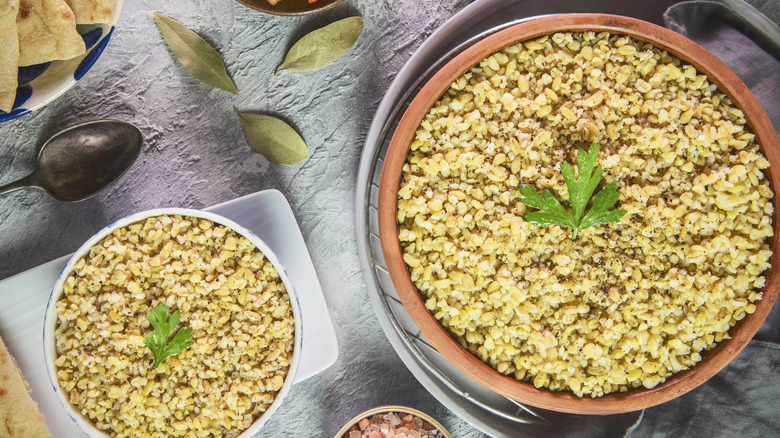16 Delicious Vegan Lebanese Main Dishes You Need To Try At Least Once
Nestled in the Levant and on the Eastern Mediterranean, Lebanon offers a rich and aromatic cuisine emphasizing nutritious, locally sourced ingredients, from olive oil and garlic to legumes, grains, sorrel, chard, and thyme. Exchanging inspiration with neighboring countries, Lebanese cuisine is widely acclaimed. As just one example, FoodieHub named a small Beirut eatery's shawarma sandwich as the World's Tastiest Sandwich in 2015.
This flavorful gastronomy presents several options that cater to most types of diets, however restrictive. You can find some of its key ingredients, like za'atar (thyme, sesame seed, and sumac mix), vine leaves, and the handy seven-spice mix (allspice, black pepper, cinnamon, cloves, coriander, cumin, and nutmeg) at your local Middle Eastern grocery store.
Many Lebanese mezze dishes are vegan or vegetarian, from mtabbal (tangy eggplant dip) and batata harra (spicy potatoes) to fteeret sbenegh (spinach triangle pie), hummus, and veggie stews. As a Lebanese foodie, here are my recommended traditional vegan dishes. They're healthy, tasty, and filling, and the spelling used here reflects each item's typical pronunciation.
1. Kibbet la'teen, or pumpkin and bulgur dough
Kibbeh, Lebanon's national dish, is made from fine bulgur wheat — an essential ingredient in a refreshing tabbouleh salad — combined with ultra-lean ground lamb or beef. It comes in many variations: fried or baked in oval balls, or fried or baked as either a single layer in a pan or as two baked layers. The stuffing and filling include more ground meat, toasted pine nuts and walnuts, sautéed onions, and various fresh and dried herbs. Daring foodies might also be interested in the raw meat version, called kibbeh nayyeh, which is drizzled with olive oil and paired with fresh mint leaves and arak (a distilled, anise-infused drink).
As for vegans, they substitute the meat in their kibbeh with either pumpkin or potato. Called kibbet la'teen, this dish is especially popular at family gatherings during Lent. The dough consists of bulgur and pureed pumpkin (or butternut squash) seasoned with marjoram and dried mint. As for the filling, it typically includes chopped sorrel or chard, chickpeas, caramelized onions, pomegranate molasses, and toasted walnuts and pine nuts. To elevate this dish with a bit more sweetness, Northern Lebanese chefs often incorporate raisins.
2. Loubyeh b zeit, or green beans in olive oil
Rich in potassium and folate, green beans are commonly found in various Middle Eastern and Mediterranean kitchens. In Lebanon, loubyeh b zeit is typically slow-cooked in a stockpot or crockpot and drizzled with a generous amount of virgin olive oil. It can be served as either an appetizer or a comforting stew, depending on whether you prefer it cold or hot, with or without cubed meat, and with or without diced tomatoes and steamed rice. The cold version of loubyeh b zeit, in particular, also requires a good squeeze of lemon juice and a lot of crushed garlic cloves.
For this dish, you should always keep two inflexible conditions in mind, though: One, the beans must be cooked from fresh or frozen — canned veggies (even the best ones) are traditionally frowned upon, especially if the crops are in season; two, the larger the amount of sautéed garlic and onions, the more flavorful and filling the dish. The vegan form of loubyeh b zeit is another Lent staple and is commonly offered among mezze items at restaurants.
3. Mihsheh koussa w batenjen, or stuffed zucchini and eggplant
In Levantine gastronomy, mihsheh (literally "stuffed") encompasses various types of veggies, from cabbage and chard rolls to green bell peppers and vine leaves. Some solid skills are needed to core out the insides of zucchinis and eggplants without poking holes in them and ruining the delicate stuffing process. Fortunately, many stores sell them pre-cored, which is more practical and less time-consuming. The only drawback is that you wouldn't be able to save the core for future use in omelets and stews, a tradition passed down for generations — there's absolutely no wasting food in a Lebanese home.
Mihsheh koussa w batenjen calls for ground meat and is served with yogurt, but the meatless version is also widely consumed by vegans, as well as during Lent. The stuffing consists of short-grain rice, finely chopped tomatoes and onions, crushed garlic cloves, and dried mint. Not to mention that regional variations, especially in the north, may additionally include chickpeas, walnuts, spicy tomato paste, and raisins.
4. Man'oushet za'atar, or thyme flatbread
Breakfast may be the most important meal of the day in Lebanon. Even if doing otherwise would make you late for work, you can't just chug your coffee and chew on some bland cereals before leaving the house. The reigning and ever-popular Lebanese breakfast consists of man'oushet za'atar, or thyme mix flatbread, now on UNESCO's Intangible Cultural Heritage List (via L'Orient Today). The dish likely dates back to the 10th century, if not earlier, and uses a highly aromatic, nutty, and tart ingredient: za'atar.
Za'atar is a thyme, oregano, sumac, and sesame seed mix found in every Levantine cuisine and consumed either dry or mixed with olive oil. Some ways to use za'atar in your cooking include sprinkling it on your salad or avocado toast, but nothing is more traditional than the early morning man'ousheh ritual in the gentle Mediterranean breeze. Whether homemade or freshly bought — most bakeries in Lebanon open as early as 6 a.m. — a man'oushet za'atar can easily turn into a full-blown convivial meal when served with green and black olives and some fresh cucumbers, tomatoes, and mint leaves. It also pairs well with coffee, homemade lemonade, and either yellow, black, or green tea. To complete this filling and flavorful breakfast, non-vegans may also add a few more sides, like fried eggs and labneh (sour, thick, and creamy strained yogurt laced with extra-virgin olive oil).
5. Ful mdammas, or fava bean stew
Another common vegan Lebanese breakfast is ful mdammas (strong emphasis on the "oo" sound). It consists of fava beans boiled over medium heat, drizzled with lemon juice and olive oil, and mixed with crushed garlic cloves and chopped parsley, onions, and tomatoes. Cumin is traditionally the star seasoning.
This fava dish is served either hot or warm, and it pairs well with black or yellow tea (or even arak if consumed later in the day). Typical sides include baleelah (warm and garlicky chickpea, tomato, and parsley salad), hummus, and/or mtabbal (smoky eggplant dip).
A traditional restaurant that serves this beloved meal will also generally offer — free of charge — a plate of pickled cucumbers, turnips, and hot peppers, as well as olives and fresh cucumbers, green onions, yellow onions, and mint leaves. All of these flavorful foods are best scooped with Lebanese bread, which is unleavened, circular, and much thinner than pita (a fact many websites and blogs fail to mention).
6. Borghol aa banadoura, or tomato bulgur
Borghol aa banadoura — nobody says "bulgur" in Lebanon — is a simple, cost-effective, and hearty meal that can be ready in 20 minutes. While fine bulgur is always used in tabbouleh and kibbeh, medium, coarse, or extra-coarse bulgur is preferred for this particular dish. The traditional recipe calls for sautéed garlic cloves and onions, tomato paste, your broth of choice, and diced tomatoes. Some people hold the garlic, while others take creative liberties by sneaking in a few more thinly chopped vegetables, such as green beans, cabbage, broccoli, and/or bell peppers. And once that fluffy, red bulgur is plated and garnished with parsley or coriander, extra-virgin olive oil is drizzled to taste.
This widely popular Lebanese meal is generally eaten cold and with a side of garlicky and lemony cabbage salad. Additionally, and especially on those hot, humid summer days, non-vegans also pair it with a refreshing side of either plain or mint-seasoned yogurt.
7. Aadas b hamod, or lemon lentil soup
Few vegan Lebanese soups are as comforting, fragrant, flavorful, and healthy as the savory and sour aadas b hamod (literally "lentils in lemon"). The traditional recipe calls for brown and/or green lentils — the red and orange varieties turn mushy very quickly — and the ideal consistency is supposed to be thick. Other essential ingredients include chopped chard, onions, mint, and cilantro, as well as cubed potatoes. Three to five garlic cloves are usually left whole to simmer in the mixture and release their strong flavor. Aadas b hamod is eaten warm in winter and cold in summer, and it freezes well for six months in an airtight container.
In recent years, chefs from various regions have gotten creative with this dish. They sometimes add finely chopped zucchini and carrots, toasted Lebanese bread crumbs, or even shell pasta. In general, Lebanese people aren't too prickly about the preparation, as long as you remember to add that final squeeze of lemon. Bousfeir (bitter orange) juice adds an even stronger sour flavor.
8. Makhlouta, or mixed whole grains stew
Makhlouta (literally "mixed") refers to a hearty, thick stew made from grains, legumes, and rice that's loaded with fibers and proteins. It can be eaten hot or cold, and it keeps well in the refrigerator for up to five days. Slow-cooked in a pressure cooker, it combines white and red kidney beans, black fava beans, chickpeas, green and brown lentils, onions, coarse bulgur, and short-grain rice. The beans and legumes should be soaked overnight to render them more digestible and reduce cooking time. Ground cumin, the main seasoning, helps deepen the flavors.
Lebanese elders often tell younger generations that this dish was spontaneously created from leftovers in the pantry and was often prepared on cold winter days, especially in the mountains. Nowadays, most of these ingredients are sold pre-packaged together in clear bags at small and artisanal markets across the country. Any leftovers from that ready-made mixture should be stored in an airtight container until you once again desire the rustic and filling makhlouta.
9. Fasolia hamra, or red kidney bean stew
While several Middle Eastern and North African countries refer to green beans as "fasolia" and red or white beans as "loubieh," in Lebanon, it's the other way around. Fasolia hamra (or "red beans") is a rustic stew with a tomato sauce base, and its main ingredients include red kidney beans, chopped sautéed onions, crushed or whole garlic gloves, and lots of olive oil. It's generally served either warm or cold and is garnished with parsley leaves. Sides may include fresh green onions, radishes, and mint leaves, as well as turnips, cucumbers, and brown onion wedges soaked in cold water.
In winter, this stew is also eaten hot with a side of steamed rice. A Lebanese steamed rice recipe typically calls for vermicelli noodles, olive oil, and either chicken, beef, vegetarian, or vegan stock. The choice of stock or bouillon depends on what else is added to the stew, as non-vegans usually prefer their red or white fasolia with big chunks of beef.
10. Mdardra/Mjaddra, or lentil and rice
Another simple, cost-effective vegan dish that's beloved across all of Lebanon is mdardra, which is loaded with fiber, protein, and vitamins. A favorite during the entire period of Lent, it's often prepared on Fridays among Christian families who also fast on that particular day of the week year-round. While this main course is called mdardra in most regions (with "mjaddra" referring to the pureed version), in other areas, it's the other way around. Regardless, all Lebanese chefs make sure they garnish the plate with a substantial amount of caramelized onions — the crisper the onions, the better.
The recipe itself calls for brown lentils, thinly diced brown onions (in addition to the topping), and short-grain rice. Mdardra may be served either warm or cold, but it's always accompanied with a salad, either fattoush or salatet malfouf (shredded cabbage, chopped tomatoes, lemon juice, olive oil, garlic, and dried mint). Non-vegans also opt for a bowl of plain or minty yogurt.
11. Ardishaoukeh w riz, or artichoke hearts with rice
Ardishaoukeh w riz is a lemony and garlicky artichoke recipe that calls for either whole or quartered bottoms (or hearts). For an ideal texture, the latter can be cooked fresh — though the steaming process is time-consuming — or from frozen. Other ingredients include toasted pine nuts, finely chopped sautéed onions and garlic cloves, lemon juice to taste, and dried cilantro. Cooked peas and both diced mushrooms and carrots are also commonly used, adding color and comfort to the uncomplicated dish. Non-vegans generally add ground beef, as well as either lamb or beef broth.
Ardishaoukeh w riz is always served hot and with a side of steamed vermicelli rice. In many restaurants, though, the artichoke, presented cold and sans rice, is often included in the mezze platters. Another favorite Lebanese appetizer is a whole steamed artichoke that's drenched in a sauce made from olive oil, lemon juice, and garlic. The leaves are picked and their pulp consumed one by one, and then the bottom is quartered and dipped in some more sauce — there's never enough.
12. Bemyeh w riz, or okra stew and rice
Okra is a rather underrated and misunderstood fruit, even though it's comforting, versatile, and packed with antioxidants, magnesium, and fiber. While Northern and Latin Americans often consume their okra either crispy and roasted or pan-fried, Lebanese people generally lean more toward the stewed version. They cook it with or without seared beef cubes, but they always make sure to serve it with a side of the ever-popular and versatile vermicelli rice. As per usual, fresh or frozen okra is preferred. For this dish, the fruit (commonly recognized as a vegetable) is simmered for 20 minutes in olive oil and tomato paste, along with some finely chopped onions, crushed or whole garlic cloves, diced tomatoes, and fresh and dried cilantro.
Though less traditional, variations in the seasoning may also include dried basil, mild or hot paprika, curry, ginger, and/or turmeric. Regardless of your preferences when it comes to this fruit, here are some tips for cooking with okra.
13. Bazella w riz, or pea stew with rice
Here's an affordable and widely available vegetable that's used in many cuisines: peas, one of the best sources for zinc and vitamins C and E. When cooking with peas (no matter their variety), there are certain factors to watch out for, such as which items not to pair them with, overcooking them to an unattractive and wrinkly texture, and inadequate seasoning.
In Lebanese cuisine, bazella w riz, or traditional pea stew, can be prepared with or without cubed or ground beef, but it's always served hot and with a side of vermicelli rice. Other than the peas themselves, the recipe calls for finely chopped sautéed onions, diced carrots, crushed garlic cloves, tomato sauce, your broth of choice, and a good drizzle of olive oil. The mixture is cooked over low heat until it thickens, and it can freeze well in an airtight container for months.
14. Falafel
While its invention is widely credited to Egyptian Copts some 1,000 years ago, falafel is a satisfyingly crunchy street food that's widely consumed all over the world. Whether served on a platter or in a sandwich, falafel is a beloved midday meal across the Middle East and North Africa. Here's how to distinguish the Lebanese version from the rest. While the patty is made exclusively with fava beans in many countries, in Lebanon, it uses chickpeas mashed with onions, parsley, and spices. The mixture is then rolled into balls and deep-fried. In some regions, fava beans may also be incorporated, resulting in a heavier, green-colored mixture.
The balls or fritters are laid on Lebanese bread (absolutely no pita or baguettes) with a selection of vegetables like fresh parsley, tomatoes, radishes, and pickled turnips. As for the sauce, it's never plain yogurt or tzatziki, but rather tarator, which consists of tahini, lemon juice, and garlic. Since tarator is dairy-free, vegans can definitely enjoy it with their falafel, alongside some hummus. If you'd like to make that sauce at home, here are some of the best store-bought tahini brands to consider.
15. Shorbit aadas, or red lentil soup
Red lentils (or orange, depending on the brand and country of origin) are packed with folate, fiber, and protein. Lebanese lentil soup is not only vegan, but also gluten-free, and it makes for a comforting meal in and of itself (though it's sometimes only considered as a light meal-starter). It's usually enjoyed on cold winter days, during Lent, and as a gentle way to break the dawn-to-dusk fast at Ramadan iftars.
Other ingredients include broth or bouillon, diced sautéed onions and crushed garlic cloves, cumin, coriander, olive oil, and a splash of lemon juice. For a chunkier texture, some Lebanese chefs also add cubed potatoes, celery stalks, and carrots, while others prefer to also season with curry, ginger, and turmeric for additional health benefits. Shorbet adas may be stored for up to five days in the fridge, but it also freezes well for future use.
16. Freekeh, or green durum wheat
Freekeh, harvested from durum wheat in the spring while the plant is still green, is the ancient ingredient you should be using more often. As a whole grain with a soft, chewy texture and a flavor that's both nutty and smoky, it definitely stands out. Moreover, it's packed with protein, manganese, and fiber.
The Lebanese version of the freekeh dish consists of red lentils and thinly sliced red and/or brown onions. It's usually topped with roasted shaved almonds, cashews, and/or pine nuts and accompanied with plain yogurt. While in other countries freekeh makes for an ideal stuffing for pigeons, in Lebanon, chicken is the main protein for that particularly filling dish. Vegans, of course, prepare it without any type of meat or animal-based bouillon/stock. Once completely cooled down, any leftover freekeh may be kept in a container or bag and frozen for at least a month.
